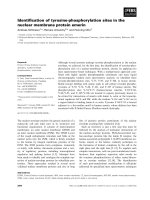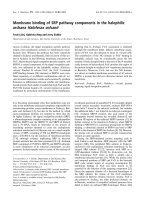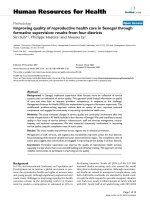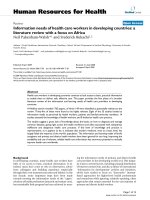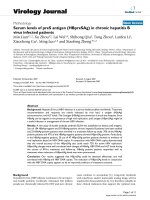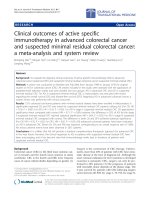Báo cáo sinh học: " Laboratory evolution of host plant utilization in the bean weevil" pps
Bạn đang xem bản rút gọn của tài liệu. Xem và tải ngay bản đầy đủ của tài liệu tại đây (722.93 KB, 12 trang )
Original
article
Laboratory
evolution
of
host
plant
utilization
in
the
bean
weevil
(Acanthoscelides
obtectus)
N
Tuci&jadnr;
D
Milanovi&jadnr;,
S
Mikuljanac
University
of
Belgrade,
Institute
for
Biological
Research
and
Faculty
of Science,
Belgrade,
Serbia
(Received
4
August
1994;
accepted
29
August
1995)
Summary -
Populations
of
the
bean
weevil
(Acanthoscelides
obtectus)
were
subjected
to
35
generations
of
artificial
selection
for
characteristics
affecting
host
utilization
when
females
were
exposed
to
a
choice
between
2
hosts
(Phascolus
vulgaris
and
Cicer
arietinum),
or
exposed
to
natural
selection
for
the
same
period,
when
only
one
host
was
available.
We
obtained
a
positive
response
for
the
percentage
of
eclosed
adults
on
the
chickpea
seeds
in
the
‘Cicer
choice’
lines
but
not
in
the
Phaseolus
lines.
In
the
post-selection
test
we
demonstrated
that
oviposition
preference
and
egg-to-adult
viability
in
the
Cicer
lines
were
higher
on
the
chickpea
than
on
the
bean
seeds.
Lines
that
had
been
selected
for
female
oviposition
preference
on
chickpea
displayed
the
same
preference
for
this
host
after
selection
was
terminated
as
lines
that
had
been
maintained
on
chickpea
seeds
without
choice.
Acanthoscelides
obtectus
/
larval
density
/
selection
/
oviposition
preference
*
Corresponding
address:
Institute
of
Zoology,
Faculty
of
Science,
PO
Box
550,
Studentski
trg
16,
11000
Belgrade,
Serbia
Résumé -
Évolution
en
laboratoire
de
l’utilisation
de
la
plante
hôte
chez
le
charançon
du
haricot
(Acanthoscelides
obtectus).
Des
populations
de
charançon
du
haricot
!Acan-
thoscelides
obtectus)
ont
été
soumises
à
35
générations
de
sélection
pour
des
caractères
affectant
l’utilisation
de
la
plante
hôte,
avec
un
choix
possible
pour
les
femelles
entre
2
hôtes
(Phaseolus
vulgaris
ou
Cicer
ariesinum),
ou
soumises
à
la
sélection
naturelle
durant
le
même
nombre
de
générations
sans
choix
de
l’hôte.
Une
réponse
positive
en
pourcentage
d’adultes
éclos
est
obtenue
dans
les
lignées
choisissant
Cicer,
mais
non
dans
celles
choisis-
sant
Phaseolus.
Dans
les
comparaisons
effectuées
à
l’issue
de
la
sélection,
on
montre
que,
dans
les
lignées
Cicer,
la
préférence
d’oviposition
et
la
viabilité
du
stade
ceuf
au
stade
adulte
sont
plus
grandes
sur
les
grains
de
Cicer
que
sur
ceux
de
Phaseolus.
De
plus,
les
lignées
sélectionnées
pour
une
oviposition
préférentielle
sur
Cicer
manifestent
après
sélection
la
même
préférence
pour
cet
hôte
que
des
lignées
maintenues
sur
Cicer
sans
possibilité
de
choix de
l’hôte.
Acanthoscelides
obtectus
/
densité
larvaire
/
sélection
/
préférence
d’oviposition
INTRODUCTION
There
have
been
many
observations
of
significant
variability
and
potential
for
host
change
in
phytophagous
insects
(see
recent
reviews
in
Via,
1990;
Jaenike
and
Holt,
1991).
These
studies
have
shown
that
both
the
behavioural
traits
which
influence
the
choice
of
plant
species
for
feeding
or
oviposition
(’preference’)
and
physiological
or
morphological
traits
that
affect
growth
and/or
reproduction
on
a
particular
host
plant
(’performance’)
may
have
a
genetic
basis.
Due
to
its
special
evolutionary
importance,
several
studies
have
separated
genetic
and
environmental
variance
in
host
preference
(Tabashnik
et
al,
1981;
Rausher,
1983;
Jaenike,
1985, 1986,
1989;
Lofdahl,
1987;
Singer
et
al,
1988;
Fox,
1993)
or
performance
(Rausher,
1984;
Via,
1984;
Hare
and
Kennedy,
1986;
Futuyma
and
Philippi,
1987;
James
et
al,
1988).
Some
of
these
short-term
experiments
have
demonstrated
a
genetic
correlation
between
preference
and
performance
(Tavormina,
1982;
Via,
1986;
Singer
et
al,
1988;
Jaenike,
1989).
However,
long-
term
experiments
examining
evolutionary
changes
in
host
preference
and/or
host
utilization
ability
in
insect
populations
are
largely
lacking
(but
see
Gould,
1979;
Wasserman
and
Futuyma,
1981;
Fry,
1990).
We
used
this
approach
in
a
laboratory
study
with
bean
weevils
(Acanthoscelides
obtectus).
We
investigated
the
changes
in
the
traits
affecting
host
utilization
that
occurred
when
bean
weevils
were
exposed,
over
35
generations,
to
a
choice
of
2
hosts
(bean
and
chickpea
seeds)
and
when
only
1
host
was
available.
Here
we
are
in
a
position
to
assess
whether
the
evolution
of
2
host
species
utilization
is
more
likely
to
proceed
by
the
propensity
of A
obtectus
females
to
accept
hosts
for
oviposition
or
by
changes
in
the
physiological
traits
that
affect
the
ability
of
weevil
larvae
to
use
different
hosts.
MATERIALS
AND
METHODS
Life
history
of
the
bean
weevil
and
experimental
conditions
A
obtectus
(Say)
is
a
bruchid
species
that attacks
seeds
of
various
leguminous
crops.
The
primary
host
of
this
weevil
is
the
common
bean
(Phaseolus
vulgaris).
The
weevil
also
attacks
chickpeas
( Cicer
arietinum)
and
other
stored
legumes
(see
Milanovi6
et
al,
1991).
The
females
deposit
eggs
in
clusters
under
or
nearby
single
seeds.
The
first
instar
larva
bores
into
a
seed
where
the
beetle
spends
its
larval
and
pupal
stages.
The
final
instar
larvae
excavate
a
chamber
just
below
the
seed
testa
and
the
presence
of
the
larva
may
be
detected
by
a
small
’window’.
After
eclosion
the
adult
chews
a
hole
in
the
seed
coat
and
pulls
itself
out
of
the
seed,
ready
to
mate.
Adults
do
not
feed
on
the
seeds.
Moreover,
they
need
neither
food
nor
water
to
produce
viable
eggs.
(For
more
details
of
A
obtectus
life
history,
see
Tuci6
et
al,
1991.)
For
the
experiments
reported
here,
we
made
use
of
different
A
obtectus
lines
established
from
a
base
population
that
had
been
maintained
in
the
laboratory
since
1986.
(This
is
the
’synthetic’
population
established
from
3
local
populations
captured
in
an
area
where
the
chickpea
is
not
available:
in
the
vicinity
of
Belgrade,
Serbia.)
The
base
population
was
reared
at
large
population
size
(about
5
000
individuals
in
each
generation)
on
P
vulgaris,
cv
’gradištanac’
seeds.
The
experiments
were
conducted
in
a
dark
incubator
at
30 °C
and
a
relative
humidity
of
about
70%.
All
seeds
were
bought
in
bulk
from
one
source.
Seeds
were
frozen
before
their
use
in
experimental
treatments.
No
food
or
water
was
offered
to
the
adults
in
the
experiment.
Experiment
l:
selection
procedures
Four
selection
regimes,
with
2
replicates
per
regime,
were
used:
2
’no-choice’
and
2
’choice’
treatments.
In
‘no-choice’
treatments
only
one
species
of
host
was
offered;
2
replicates
(the
’Phaseolus
lines’)
were
reared
on
common
bean
seeds,
the
other
2
(the
‘Cicer
lines’)
were
maintained
on
chickpea
seeds.
Since
no
selection
for
host
preference
was
imposed,
the
weevils
should
have
experienced
natural
selection
for
larval
adaptation
to
host
species.
Each
replicate
line
was
initiated
with
100
randomly
chosen
adults
from
the
base
population.
These
replicates
were
kept
in
separate
bottles
containing
200
seeds
of
the
appropriate
host.
This
procedure
was
repeated
during
35
non-
overlapping
generations.
’Choice’
treatments
also
produced
replicated
Phaseolus
and
Cicer
lines
which
began
with
10
groups,
each
comprising
10
pairs
of
one-day-old
weevils.
The
weevils
were
placed
in
Petri
dishes
(50
mm
diameter)
which
contained
equal
numbers
of
bean
seeds
and
chickpea
seeds
of
about
the
same
size
(7
mm).
Seeds
were
place
in
each
dish
so
that
bean
covered
one
half
and
chickpeas
the
other
half of
the
dish.
The
Petri
dishes
were
kept
in
a
dark
incubator
and
from
about
3
weeks
onward
were
checked
daily
until
the
eclosion
of
adults
started.
(The
eclosion
is
recognized
by
the
’windows’
on
the
seed
testa
becoming
black;
otherwise
the
windows
are
grey.)
At
that
time,
beans
and
chickpeas
were
separated.
In
2
replicate
lines
(the
’choice
Phaseolus
lines’),
bean
seeds
from
all
10
dishes
were
kept
together
in
a
single
bottle.
The
number
of
eclosed
adults
from
beans
and
chickpeas
was
then
counted.
From
the
newly
emerged
adults
from
bean
seeds
we
chose,
again
randomly,
10
groups
with
10
pairs
of
beetles,
in
order
to
establish
a
new
generation,
which
was
again
offered
a
choice
between
beans
and
chickpeas.
This
procedure
was
repeated
for
35
generations.
In
the
’choice
Cicer line’
the
same
procedure
was
applied,
except
that
new
generations
were
founded
by
adults
emerging
from
the
chickpeas.
In
’choice’
treatments,
the
selection
criterion
was
the
percentage
of
eclosed
adults
which
originated
from
the
appropriate
host
(hereafter
denoted
as
’the
percentage
of
eclosed
adults’).
We
have
chosen
this
composite
trait
(which
includes
the
number
of
eggs
laid,
larval
preference
and
larval
performance)
because
the
eggs
are
usually
deposited
underneath
the
host
seeds,
and
therefore
they
are
difficult
to
count
without
harming
them.
Thus,
the
information
on
the
oviposition
preference
and
larval
performance
is
crucial
for
the
understanding
of
the
changes
in
the
utilisation
by
A
obtectus
under
applied
selection
regimes.
(On
the
basis
of
our
exploratory
experiment
(unpublished
data),
we
believe
that
larval
preference
does
not
determine
host
choice
because
first
instar
larvae
are
not
very
vagile
(only
this
instar
has
legs
and
can
walk
to
find
a
place
to
enter
the
seeds;
usually
they
remain
underneath
the
seed
where
the
eggs
were
laid).)
In
order
to
determine
how
much
selected
lines
diverged
from
each
other
in
traits
affecting
host
utilization
2
post-selection
tests
were
performed.
The
first
test
was
designed
to
measure
the
oviposition
preference,
whereas
in
the
second
larval
performance
of
different
lines
was
estimated.
Experiment
2:
oviposition
preference
To
rule
out
the
effect
of
plant
seeds
where
weevils
fed
during
the
larval
stages
as
a
possible
reason
for
the
divergence
among
lines,
we
reared
all
lines
in
both
host
seeds
after
the
end
of
the
selection,
and
then
tested
their
offspring
with
regard
to
oviposition
preference
in
a
mixed-host
environment.
Two
groups
of
about
50
pairs
of
newly
emerged
weevils
from
each
replicate
line
were
collected.
The
first
group
was
reared
for
one
generation
on
beans
and
the
second
on
chickpeas.
After
that,
15
5
pairs
of
weevils
within
each
line/host
seed
treatment
were
tested
individually
for
oviposition
preference
in
Petri
dishes
containing
equal
numbers
of
bean
and
chickpea
seeds.
Although
the
seeds
were
not
distributed
randomly
in
the
Petri
dishes
(we
applied
the
same
conditions
as
in
the
’choice’
selection
regimes),
it
is
very
unlikely
that
this
could
produce
any
bias
in
the
oviposition
preference
because
weevil
females
exhibited
a
pre-oviposition
period
(see,
for
example,
Pouzat,
1978).
The
number
of
eggs
deposited
on
each
host
seed
were
counted.
Oviposition
preference
was
measured
only
during
the
first
4
d
of
female
life
span
(this
period
covers
about
3/4
of
the
female’s
fecundity,
see
Tuci6
et
al,
1990).
Experiment
3:
larval
performance
To
determine
whether
larval
survival
differed
among
the
lines,
the
egg-to-adult
viability
and
pre-adult
developmental
time
were
also
tested
after
the
termination
of
the
selection
experiment.
A
sample
of
about
100
one-day-old
adults
was
collected
randomly
from
one
replicate
within
each
treatment,
and
weevils
were
mated
in
groups.
These
4
groups
were
kept
in
separate
Petri
dishes
containing
bean
seeds
only.
Females
were
allowed
to
lay
eggs
for
24
h.
After
removal
of
the
weevils,
the
eggs
were
counted
and
collected
from
the
dish
bottom
and
the
surface
of
the
beans
using
a
paint
brush.
Eggs
collected
from
each
line
were
divided
into 2
equal
batches,
one
being
set
up
on
5
Petri
dishes
containing
bean
seeds
and
the
other
on
Petri
dishes
containing
chickpeas.
To
prevent
differential
larval
densities,
each
Petri
dish
contained
20
seeds
and
50
eggs.
In
addition,
a
density
of
about
2-3
larvae
per
grain
is
too
low
to
express
pronounced
effects
on
either
survival
or
pre-adult
development
(Aleksi6
et
al,
1993).
Thus,
the
total
number
of
eggs
used
for
the
estimation
of
the
egg-to-adult
viability
and
pre-adult
developmental
time
for
each
line
and
host
was
50
x
5
=
250.
The
egg-to-adult
viability
is
defined
as
the
percentage
of
adults
on
each
host
seed.
The
duration
(in
days)
from
deposition
of
eggs
to
emergence
of
adults
was
used
to
estimate
preadult
developmental
time.
Statistical
procedures
Multiway
analyses
of
variance
for
the
percentage
of
eggs
laid
on
chickpeas
and
for
the
4
d
fecundity
(Experiment
2)
were
performed
by
using
the
PC-EMS
program
(Dalla,
1985).
We
have
dealt
here
with
4
factors:
selection
treatment
(factor
A-fixed),
host
(B-fixed),
replicate
lines
(C-random)
and
rearing
host
(D-
fixed).
Replicates
(C)
were
nested
within
the
selection
treatment
(A)
and
host
(B)
interaction.
The
model
description
was:
A
+
B
+
AB
+
C(AB)
+
D
+
AD
+
BD
+
ABD
+
C(AB)D,
with
mean
and
error
terms
not
stated
explicitly.
In
this
model
we
have
3
’error
terms’
(numbers
correspond
to
levels
in
the
model
under
’source
of
variation’
in
table
II
below):
(10)
error
(within groups),
(9)
C(AB)D
and
(8)
C(AB).
In
F-tests,
terms
D,
AD,
BD
and
ABD
and
C(AB)
were
tested
against
(9)
and
terms
A,
B and
AB
were
tested
against
(8).
The
egg-to-adult
viability
and
pre-adult
developmental
time
(Experiment
3)
were
analysed
by
3-way
ANOVA.
The
factors
were:
selection
treatment
(factor
A-fixed),
host
(B-fixed)
and
rearing
host
(C-fixed).
Since
here
we
are
dealing
with
a
Model
I
(fixed
effects
model)
ANOVA,
each F
value
refers
to
the
error
MS.
RESULTS
Responses
to
selection
The
percentages
of
eclosed
adults
on
chickpeas
or
beans
over
the
choice
selection
regimes
are
presented
in
figure
1.
It
is
evident
that
increases
in
the
percentages
of
eclosed
adults
on
chickpeas
did
occur
in
both
replicates
of
the
Cicer
line
(fig
1B),
but
not
in
the
choice
Phaseolus
line
(fig
1A).
For
each
replicate
we
estimated
regression
coefficients
for
the
percentage
of
eclosed
adults
on
the
appropriate
host
(after
arcsin
transformation)
on
generation
of
selection.
The
coefficients
were
highly
significant
for
both
choice
Cicer line
(b
l
=
0.67
f 0.17;
P
<
0.001;
b2
=
0.86
t 0.19;
P
<
0.001).
A
test
of
equality
of
regression
coefficients
did
not
reveal
significant
differences
between
these
2
replicates
(F
S
=
0.56;
P
>
0.05).
In
contrast,
both
regression
coefficients
for
the
Phaseolus
line
were
non-significant
(b,
=
0.07
+
0.14;
b2
=
-0.04
+ 0.16).
Post-selection
tests
The
mean
percentages
of
eggs
laid
on
chickpeas
of
all
the
lines,
reared
on
both
hosts
and
tested
in
a
mixed-host
environment,
are
listed
in
table
I.
A
striking
feature
of
these
data
is
the
large
difference
between
hosts
where
selection
was
imposed.
The
mean
percentages
of
eggs
laid
on
chickpeas
in
the
Cicer
lines,
no
matter
what
the
treatment
or
the
rearing
host
were,
were
higher
than
those
in
the
Phaseolus
lines.
This
finding
was
statistically
confirmed
by
the
results
of
the
factorial
analysis
of
variance
(table
II).
In
addition,
the
host
seeds
where
females
developed
during
larval
stages
(’rearing
host’
in
table
II),
and
interaction
’selection
treatment
x
rearing
host’
(A
x
D
in
table
II),
contributed
significantly
to
host
preference
variation.
The
mean
percentages
of
eggs
laid
on
chickpeas
in
the
’no-choice’
and
’choice’
treatments
were,
however,
not
different
from
each
other
(F
=
0.95;
P
>
0.05,
table
II).
Although
the
results
in
table
I
suggested
that
the
mean
number
of
eggs
laid
per
female
is
higher
in
Phaseolus
than
in
Cicer
lines,
this
was
not
confirmed
by
the
analysis
of
variance
(table
II).
Since
the
average
of
the
4
d
fecundity
varied
considerably
across
rearing
host
x
replicate
cells
(see
line
9
of
table
II),
none
of
the
main
effects
(’selection
treatments’,
’host
seeds’
and
’rearing
host’;
table
II)
was
statistically
significant.
number
of
tested
females
is
equal
(15)
in
all
groups.
The
relationship
between
oviposition
preference
for
chickpea
and
fecundity
was
tested
by
calculating
correlation
coefficients.
We
estimated
4
correlation
coefficients
on
the
pooled
data
over
replicates
and
’rearing
hosts’
(table
III).
Both
the
’no-choice’
and
’choice’
Phaseolus
lines
showed
that
oviposition
preference
was
negatively
correlated
with
fecundity.
However,
no
such
relationship
was
found
for
the
Cicer
lines
(neither
correlation
was
different
from
zero,
table
III).
The
average
viabilities
were
estimated
from
5
Petri
dishes,
each
containing
50
eggs.
The
numbers
of
tested
individuals
for
developmental
time
are
given
in
parentheses.
As
for
the
preference,
one
might
expect
that
a
long-term
rearing
of
the
bean
weevils
on
the
chickpea
seeds
will
lead
to
increase
of
larval
performance
on
that
host.
The
results
in
table
IV
show
that
this
could
be
the
case
for
the
egg-to-adult
viability
but
not
for
the
pre-adult
developmental
time.
On
the
beans
the
average
viabilities
(pooled
over
’no-choice’
and
’choice’
treatments)
are
62.4
and
50.6%
in
the
Phaseolus
and
Cicer
lines,
respectively.
On
the
chickpeas
these
averages
are
54.8%
(the
Phaseolus
line)
and
57.4%
(the
Cicer line).
This
trend
is
statistically
confirmed
by
the
significant
’host
x
rearing
host’
interaction
term
in
the
analysis
of
variance
(table
V).
All
other
effects
did
not
contribute
significantly
to
the
observed
variation
of
the
egg-to-adult
viability.
A
3-way
ANOVA
of
the
pre-adult
developmental
time,
on
the
other
hand,
showed
significant
effects
of
selection
treatment,
rearing
host
and
all
interactions
except
those
between
host
and
rearing
host
(B
x
C
in
table
V).
DISCUSSION
We
obtained
positive
responses
to
selection
for
the
percentage
of
eclosed
adults
on
the
chickpea
seeds
in
both
’choice’
Cicer
lines
(fig
1).
The
absence
of
any
responses
in
the
Phaseolus
lines
most
likely
reflects
the
fact
that
local
populations,
from
which
the
base
population
has
been
established
(see
Materials
and
methods),
used
bean
seeds.
Hence,
we
have
observed
substantial
genetic
variance
for
the
use
of
chickpea
seeds,
which
are
not
available
in
the
area
where
the
weevils
were
collected.
Our
results
resemble
the
data
of Lofdahl
(1987)
who
worked
with
Drosophila
rnojavensis
offered
a
novel
cactus
species.
There
is
one
more
interesting
aspect
of
the
data
depicted
in
figure
1.
In
the
chickpea
selected
lines
(fig
1B),
the
first
generations
showed
a
preference
for
beans
as
only
about
20%
of
eclosed
adults
originated
from
the
chickpea.
By
the
end
of
the
experiment
these
weevils
expressed
a
preference
for
chickpea,
with
more
than
50%
of
the
adults
emerging
from
this
host.
It
seems,
therefore,
that
the
actual
rank
order
preference
has
been
changed
as
a
result
of
selection.
These
observations
do
not
support
prediction
of
a
’general
model
for
individual
host
selection’
postulated
by
Courtney
et
al
(1989).
These
authors
argue
that
changes
in
host
use
are
due
to
changes
in
overall
threshold
for
acceptage
of
any
host,
and
that
changes
in
rank
order
preference
are
not
expected.
Contrary
to
our
results,
2
studies
(Harrison,
1987;
Prokopy
et
al,
1988),
however,
support
the
Courtney
et
al
(1989)
model
of
evolution
of
host
utilization.
Both
of
these
studies
have
considered
host
acceptance
in
populations
where
ancestry
is
known,
and
where
derived
populations
have
evolved
novel
host
utilization.
The
observed
responses
to
selection
indicate
the
presence
of
additive
genetic
variation
in
one
or
both
of
the
2
constituent
traits
of
the
selection
criterion:
the
oviposition
behaviour,
which
determines
whether
or
not
the
females
accept
the
host,
and
egg-to-adult
survival
on
different
hosts.
In
the
post-selection
test,
we
demonstrated
that
in
Cicer
lines
both
the
oviposition
preference
(table
I)
and
egg-
to-adult
viability
(table
IV)
were
higher
on
the
host
where
selection
was
imposed.
Accordingly,
it
could
be
concluded
that,
as
a
result
of
the
long-term
rearing
of
weevils
on
the
chickpeas,
females
tend
to
choose
oviposition
sites
in
which
their
offspring
have
a
higher
probability
of
surviving.
Although
some
theoretical
analyses
predict
that
genetic
correlation
between
preference
and
performance
could
be
responsible
for
the
maintenance
of
genetic
variation
in
habitat
selection
(Bush,
1974;
but
see
review
in
Jaenike
and
Holt,
1991),
it
is
well
known
that
genetic
variation
in
preference
may
exist
without
correlated
variation
in
performance
and
vice
versa
(eg,
Gould,
1979;
Wasserman
and
Futuyma,
1981;
Tabashnik,
1983;
Futuyma
and
Moreno,
1988).
In
this
study,
however,
we
have
presented
evidence
for
the
genetic
correlation
between
preference
and
performance.
Such
correlations
may
be
attributable
either
to
a
fortuitous
pleiotropic
relationship
due
to
biochemical
and/or
developmental
processes
common
to
oviposition
preference
and
egg-to-adult
viability
or
to
natural
selection
building
up
linkage
disequilibrium
between
genes
that
influence
these
traits.
Singer
et
al
(1988)
envisaged
a
way
in
which
a
correlation
between
preference
and
performance
could
be
produced.
We
believe
that
their
interpretation
could
be
applied
to
our
data
as
well.
Their
scenario
favours
the
linkage
disequilibrium
hypothesis
and
the
primacy
of
physiological
adaptation
over
the
host
selection
behaviour.
Although
this
does
not
influence
our
conclusion
given
above,
a
post-selection
test
of
another
fitness-related
trait,
pre-adult
developmental
time
yielded
a
more
complicated
picture
(table
IV).
Pre-adult
developmental
time,
which
could
be
influenced
by
some
physiological
characters
(eg,
the
ability
to
overcome
certain
toxic
compounds,
assimilation
efficiency,
etc),
differed
significantly
between
the
’no-choice’
and
’choice’
selection
treatments,
but
not
between
host
seeds
on
which
selection
was
imposed
(bean
vs
chickpea).
Bearing
in
mind
our
methods
of
selection,
this
was
quite
an
expected
result.
In
order
to
collect
a
sufficient
number
of
one-day-
old
weevils
(100
females
and
100
males)
for
the
’choice’
treatments,
new
generations
were
established,
usually,
from
the
first
200
newly
emerged
weevils.
Hence,
the
faster
pre-adult
development
in
the
’choice’
lines
was
the
result
of
inadvertent
selection
for
fast
development
in
these
lines.
A
third
fitness-related
trait
(fecundity)
was
also
measured
at
the
end
of
the
selection
experiments
(table
I).
We
counted
the
number
of
eggs
laid
by
individual
females
during
the
first
4
d,
so
this
is
a
kind
of
’realized
fecundity’
(Wasserman
and
Futuyma,
1981).
Since
the
realized
fecundity
mainly
depended
on
nutritional
history
during
the
larval
stage,
our
data
suggest,
contrary
to
expectation,
that
the
primary
host
(bean
seeds)
is
not
nutritionally
superior
to
the
chickpea.
However,
we
have
observed
that
only
in
the
Phaseolus
lines
more
fecund
females
laid
significantly
fewer
eggs
on
the
chickpeas
than
on
the
beans
(table
III).
A
negative
correlation
between
realized
fecundity
and
oviposition
preference
was
more
pronounced
in
the
Phaseolus
choice
line.
These
negative
correlations
between
oviposition
and
realized
fecundity
can
be
tentatively
explained
if
increased
choice
requires
females
to
spend
more
time
searching
for
the
preferred
host,
thus
reducing
laying
time.
Also,
the
lower
magnitude
of
these
correlations
in
’no-choice’
lines
may
be
explained
through
selection
favouring
females
that
do
not
spend
time
searching
for
the
lacking
host,
as
well
as
through
a
correlated
response
to
selection
for
adaptation
to
the
host.
It
seems,
therefore,
that
&dquo;selection
on
host
choice
may
be
one
factor
maintaining
genetic
variance
in
fecundity,
an
important
fitness
component&dquo;
(Courtney
et
al,
1989).
Hence,
an
important
implication
of
the
results
presented
in
table
III
would
be
in
the
explanation
for
the
high
level
of
genetic
variance
for
fecundity
observed
previously
in
A
obtectus
(Tuci6
et
al,
1990)
and
Drosophila
populations
(Roff
and
Mousseau,
1987;
Tuci6
et
al
1988)
and
which
appears
to
contradict
Fisher’s
(1930)
Fundamental
Theorem
(ie
the
expectation
that
populations
at
selective
equilibria
have
little
or
no
heritable
variation
for
traits
with
large
effects
on
fitness).
The
selection
experiments
with
Callosobruchus
maculatus
(Wasserman
and
Futuyma,
1981)
showed
that
a
population
that
had
been
selected
for
female
oviposition
preference
on
a
given
host
species
displayed
the
same
preference
for
this
host
after
the
selection
as
a
population
that
had
been
maintained
without
choice
on
the
same
host.
These
findings
are
in
agreement
with
our
observation
for
the
no-choice
and
choice
Cicer
lines
(table
I).
According
to
Wasserman
and
Futuyma
(1981),
the
main
reason
why
a
population
will
evolve
a
preference
for
the
host
to
which
it
is
exposed
lies
either
in
&dquo;a
lowering
of
a
specific
threshold
of
response
to
the
particular
host
with
which
they
are
confined,
or
a
lower
general
response
threshold,
so
that
less
discriminatory
genotypes
(which
may
come
to
accept
any
of
several
host
species)
are
favoured&dquo;
(p 615).
ACKNOWLEDGMENTS
We
thank
the
anonymous
reviewers
for
their
helpful
suggestions
and
comments
on
the
manuscript.
REFERENCES
Aleksi6
I,
Gliksman
I,
Milanovi6
D,
Tuci6
N
(1993)
On
r-
and
K-selection:
evidence
from
the
bean
weevil
(Acanthoscelides
obtectus). Z
Zool
Syst
Evolutforsch
31,
259-268
Buch
GL
(1974)
The
mechanism
of
sympatric
host
race
formation
in
the
true
fruit
flies
(Tephritidae).
In:
Genetic
Mechanisms
of
Speciation
in
Insects
(MJD
White,
ed),
Australian
and
New
Zealand
Books,
Sydney,
3-23
Courtney
SP,
Chen
GK,
Gardner
A
(1989)
A
general
model
for
individual
host
selection.
Oikos
55,
55-65
Dallal
GE
(1985)
A
program
to
contrast
EMS
tables.
USDA
Human
Nutrition
Research
Center
on
Aging,
Boston,
MA
Fisher
RA
(1930)
The
Gev.etical
Theory
of Natural
Selection.
Clarendon
Press,
Oxford
Fox
CW
(1993)
A
quantitative
genetic
analysis
of
oviposition
preference
and
larval
performance
on
2
hosts
in
the
bruchid
beetle.
Callosobruchus
maculatus.
Evolution
47,
166-175
Fry
JD
(1990)
Trade-offs
in
fitness
on
different
hosts:
evidence
from
a
selection
experiment
with
a
phytophagous
mite.
Am
Nat
136,
569-580
Futuyma
DJ,
Philippi
TE
(1987)
Genetic
variation
and
covariation
in
responses
to
host
plant
by
Alsophyla
pomentaria
(Lepidoptera:
Geometridae).
Evolution
41,
269-279
Futuyma
DJ,
Moreno
G
(1988)
The
evolution
of
ecological
specalization.
Ann
Rev
Ecol
Syst
19,
207-233
Gould
F
(1979)
Rapid
host
range
evolution
in
a
population
of
the
phytophagous
mite
Tetranychus
urticae
Koch.
Evolution
33,
791-802
Hare
JD,
Kennedy
GG
(1986)
Genetic
variation
in
plant-insect
associations;
survival
of
Le
P
tirotarsa
decemlineata
population
on
Solanum
carolinense.
Evolution
40,
1031-1043
Harrison
GD
(1987)
Host-plant
discrimination
and
evolution
of
feeding
preference
in
the
Colorado
potato
beetle
Leptinotarsa
decemlineata.
Phys
Ent
12,
407-415
Jaenike
J
(1985)
Genetic
and
environmental
determinants
of food
preference
in
Drosophila
tripunctata.
Evolution
39,
362-369
Jaenike
J
(1986)
Genetic
complexity
of
host
selection
behaviour
in
Drosophila.
Proc
Natl
Acad
Sci
USA
83,
2148-2151
Jaenike
J
(1989)
Genetic
population
structure
of
Drosophila
tripunctata:
patterns
of
variation
and
covariation
of
trait
affecting
resource
use.
Evolution
43,
1467-1482
Jaenike
J,
Holt
RS
(1991)
Genetic
variation
for
habitat
preference:
evidence
and
explana-
tions.
Am
Nat
137,
567-590
James
AC,
Jakubczak
J,
Riley
PM,
Jaenike
J
(1988)
On
the
causes
of
monophagy
in
Drosophila
guinaria.
Evolution
42,
317-338
Lofdahl
K
(1987)
A
genetic
analysis
of
habitat
selection
in
the
cactophylic
species,
Drosophila
mojavensis.
In:
Evolutionary
Genetics
of
Invertebrate
Behaviour
(MD
Huttel,
ed),
Plenum
Press,
New
York,
NY,
77-91
Milanovi6
D,
Aleksi6
I,
luci6
N
(1991)
Nonrandom
association
between
host
choice
and
fitness
in
bean
weevil
(Acanthoscelides
obtectus).
Z
Zool
Syst
Evolut-forsch
29,
108-114
Pouzat
J
(1978)
Host
plant
chemosensory
influence
on
oogenesis
in
the
bean
weevil,
Acanthoscelides
obtectus
(Coleoptera:
Bruchidae). Ent
E!p
and
Appl
24,
401-408
Prokopy
RJ,
Diehl
SR,
Cooley
SS
(1988)
Behavioural
evidence
for
host
races
in
host
races
in
Rhagoletis
pomonella
flies.
lEcologia
76,
138-147
Rausher
MD
(1983)
Conditioning
and
genetic
variation
as
causes
of
individual
variation
in
the
oviposition
behaviour
of
the
tortoise
beetle
Deloyala
guttata.
Anim
Behav
31,
743-747
Rausher
MD
(1984)
Trade-offs
in
performance
on
different
hosts:
evidence
from
within-
and
between-site
variation
in
the
beetle
Deloyala
guttata.
Evolution
38,
582-595
Roff
D,
Mousseau
TA
(1987)
Quantitative
genetics
and
fitness:
lessons
from
Drosophila.
Heredity
58,
103-118
Scheiner
SM,
Lyman
RF
(1989)
The
genetics
of phenotypic
plasticity.
I.
Heritability.
J
Evol
Biol
2,
95-107
Singer
MC,
Ng
D,
Thomas
CD
(1988)
Heritability
of
oviposition
preference
and
its
relationship
to
offspring
performance
within
a
single
insect
population.
Evolution
42,
977-985
Tabashnik
BE
(1983)
Host
range
evolution:
the
shift
from
native
legume
hosts
to
alfalfa
by
the
butterfly,
Colias
philodice
eriphyle.
Evolution
37,
150-162
Tabashnik
BE,
Wheelock
H,
Rainbolt
JD,
Watt
WB
(1981)
Individual
variation
in
oviposition
preference
in
the
butterfly,
Colias
eurytheme.
lEcologia
50,
225-230
Tavormina
S
(1982)
Sympatric
genetic
divergence
in
the
leaf
mining
insect
Liriomyza
brassicae
(Diptera:
Agromyzidae).
Evolution
36,
523-535
Tuci6
N,
Cvetkovi6
D,
Milanovi6
D
(1988)
The
genetic
variation
and
covariation
among
fitness
components
in
Drosophila
melanogaster
females
and
males.
Heredity
60,
55-60
Tuci6
N,
Cvetkovi6
D,
Stojiljkovi6
V,
Milanovi6
D,
Bejakovi6
D
(1990)
The
effects
of
selection
for
early
and
late
reproduction
on
fecundity
in
bean
weevil
(Acanthoscelides
obtectus).
Genetica
80,
221-227
T’uci
6
N,
Milosevic
M,
Gliksman
I,
Milanovi6
D,
Aleksi6
I
(1991)
The
effects
of
larval
density
on
genetic
variation
and
covariation
among
life-history
traits
in
the
bean
weevil
(Acanthoscelides
obtectus).
Funct
Ecol
5,
525-534
Via
S
(1984)
The
quantitative
genetics
of
polyphagy
in
an
insect
herbivore.
I.
Genotype-
environmental
interaction
in
larval
performance
on
different
host
plant
species.
Evolu-
tion
38,
881-895
Via
S
(1986)
Genetic
covariance
between
oviposition
preference
and
larval
performance
in
an
insect
herbivore.
Evolution
40,
778-785
Via
S
(1990)
Ecological
genetics
and
host
adaptation
in
herbivorous
insects:
the
experi-
mental
study
of
evolution
in
natural
and
agricultural
systems.
Ann
Rev
Entomol
35,
421-446
Wasserman
SS,
Futuyma
DJ
(1981)
Evolution
of
host-plant
utilization
in
laboratory
populations
of
the
southern
cowpea
weevil,
Callosobruchus
mauculatus.
Evolution
35,
605-617



